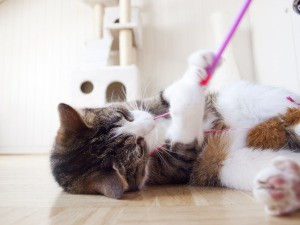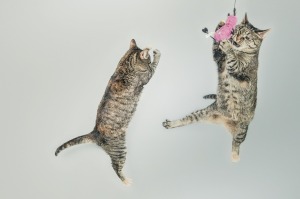The Importance of Play in Reducing Behavior Problems in Indoor Cats
A recent study published in the Journal of Veterinary Behavior demonstrates the importance of environmental enrichment in the well-being of indoor cats. Indoor cats lead longer, safer and healthier lives than outdoor cats. But what about their emotional health? An indoor cat who does not experience adequate play and interaction with his owners, and who isn’t provided with enough stimulating toys, is more likely to experience behavioral problems.
Behavior problems are sadly a common reason why cats are surrendered to shelters. The most common feline behavior problems are aggression towards owners, visitors, or other cats in the home and urination and defecation outside of the litterbox.
Researchers studied 277 indoor cats brought to veterinary practices for non-behavioral issues. The owners were surveyed about their provision of toys and activities for the cats. Results show that the average number of toys and activities per cat is 7. The most popular toys are fur mice, catnip toys and balls with bells. A majority of the cat owners reported that they make the toys available to the cats all the time. All of the owners reported playing with their cats, most 2 or more times a day for an average of 5-10 minutes per play session. Owners who reported longer play periods also reported fewer behavioral problems.
Approximately 60% of all owners reported that their cat had engaged in at least one of the behavior problems at some time. About 50% of them had reported the problem to their vet. The two most common behavior problems seen in the study are aggression towards owners and inappropriate urination. Female cats were found to be less likely to have behavior problems than males.
Results indicate that environmental enrichment is an important component to feline emotional health. Indoor cats who do not receive adequate play and attention are more likely to demonstrate behavioral problems than those who engage in more frequent and sustained play and interaction.
For more on the study, click HERE.

